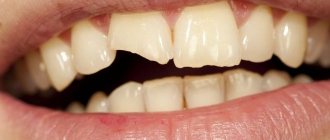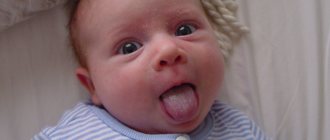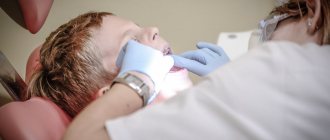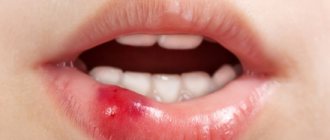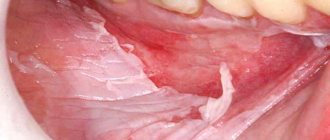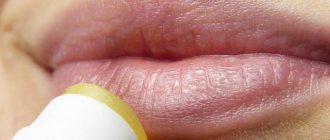- What to do if a child breaks a tooth?
- A child's tooth is dislocated.
- If a child knocks out a baby tooth, what should you do?
- Prevention of childhood dental injuries.
Children differ from adults by being more active and playful.
These properties allow them to quickly understand the world around them. But sometimes children's pranks lead to unpleasant consequences, such as a knocked out or chipped tooth. Injuries to the dentition can occur either due to negligence or as a result of weakening of the enamel. Whatever the reason, parents urgently need to solve this problem.
And the only sure way to avoid complications after a chipped tooth is to see a dentist.
What to do if a child breaks a tooth?
The first thing to do is to calm the child and examine for other injuries that require urgent medical attention. If these are not observed, then rinse your baby’s mouth with water, blot the injury site with a clean napkin, and also try to find the chipped part of the tooth.
If the pain is severe, the child should be given a pain reliever. If a red dot is visible on the tooth, this means that the nerve has been exposed. In this case, you should not give your child cold or hot drinks and go to the dentist as soon as possible.
If there is no red dot on the damaged tooth, it has not moved, and the jaw can close normally, then there is no particular danger. Nevertheless, it is still necessary to see a doctor, since the tooth has lost its protective layer and is now more susceptible to infections and all kinds of diseases. Without proper treatment, the nerve may simply die, resulting in the loss of the entire tooth.
Causes of dental injury
A large or barely noticeable gap in the teeth area spoils the entire appearance. To treat and restore a tooth, you need to know the main causes of dental injury. There are several of them.
1. Mostly, children receive mechanical injuries from a fall or bruise, when parents see, for example, that a front tooth has broken at the root.
2. Children's teeth are not yet strong enough to experience serious jaw load. Therefore, it is worth making sure that children do not get used to, for example, clenching their teeth tightly.
3. If half of the tooth crown is broken, it is due to a poor-quality filling.
4. The filling or inlay may pop out or break when it reaches the end of its service life.
5. Teeth with thinned enamel become a risk area.
6. Due to thinned enamel, the tooth may be destroyed due to carious formation.
7. The quality and properties of food also affect tooth decay.
Avoid giving children foods that are too hard or rough. Even seeds can cause a piece of a tooth to break off. To avoid all these unpleasant consequences, you will need to pay more attention to care, as well as the quality of food.
To strengthen tooth enamel, you need a sufficient amount of calcium in the body. To strengthen the structure, remineralization is required. The appearance of microcracks is due to the fact that the child receives food that is too contrasting. This affects the condition of the enamel, it becomes vulnerable. A weakened tooth may break at some point. This is the result of exposure to food and ingestion of hot and frozen drinks.
Tooth dislocation in a child
Tooth luxation is a displacement of the crown in its alveolus as a result of physical impact. This injury is especially common in children and is common among all types of dental injuries. Symptoms of a dislocation may include:
- displacement of the dental crown back, forward, sideways
- the tooth is rotated around its axis
- the child cannot close his jaw completely
- tooth tissues are separated from the gums
- the soft tissue around the tooth swells and bleeds
- the tooth is loose, but still stays in the socket
It is imperative to see a dentist, even if the tooth looks almost undamaged. There may be a broken root or damaged nerve inside it. Such a tooth can be saved, the main thing is not to put pressure on it and not to self-medicate.
Only a qualified dentist can correctly assess the damage and prescribe effective treatment. If you see a doctor within the next hour after receiving an injury, the chances of saving the tooth increase significantly.
Now let's consider another situation. A wisdom tooth chipped into the gums - what to do?
If a tooth breaks or falls out, do not treat the area with peroxide, alcohol, touch the wound, or brush with a toothbrush. In a situation where there is a suspicion of not just a broken tooth, but also a broken jaw, she needs to be provided with peace and immobilized. To do this, you will need to make a bandage passing through the top of the head.
Severe trauma to the jaw can lead to nosebleeds. In this case, it is necessary for the child to lower his head and place a cold compress on the bridge of his nose. At the same time as these actions, someone should call the doctor.
After identifying the nature of the damage in the hospital using an X-ray, it will be possible to determine how damaged the surrounding tissues are, whether there are dislocations or subluxations.
If a child knocks out a baby tooth, what should you do?
In the case of baby teeth, we are not talking about restoring them or putting them back. It is not necessary to look for the knocked-out fragment. But it is necessary to take care of the molar tooth germ, which is located in the gum. You cannot injure it or allow it to get infected, so a visit to the dentist is mandatory.
If the baby accidentally knocks out a molar, it must be found and returned to the socket as quickly as possible. In this case, the tooth should be washed in saline solution or plain water, and also held by the crown part so as not to cause an infection.
The best and most predictable option is to return the tooth to the socket within the first 15 minutes. This increases the chance of its recovery to 90%. If you are afraid to insert a tooth yourself, then you should see a doctor as soon as possible.
In this case, the tooth must be transported in a suitable environment - saline solution, milk, water.
Treatment methods
Broken permanent tooth.
First of all, the dentist will assess the extent of the damage and the condition of the pulp.
Possible chipping of enamel or crown at the dentin level. In such situations, the pulp is not affected; children complain only of visible defects in the hard tissues. But a tooth fracture in a child within the dentin or the entire crown causes pain while eating, scratches the tongue, lips and cheeks.
Treatment:
- The dentist sands down the sharp edges and coats the surface with a remineralizing agent. Without opening the pulp, a filling made of composite materials is applied to the fracture site;
- if you find a fragment and bring it in saline solution, the doctor will restore the tooth fragments. This method is preferable - it ensures precise contact with the bite, and there is no shrinkage or change in color of the crown over time;
- a large part of the tooth broke off and could not be found - the dentist will perform a restoration. Recreates the anatomical structure and ideal fit to antagonist teeth. This is necessary for chewing and proper jaw development.
- The tooth is broken, the pulp and nerve are visible.
It is important to contact a specialist within 24 hours to preserve the pulp. Then the tooth will continue to grow and become stronger. And for a doctor this is a primary task.
If the pulp cannot be saved, the dentist will clean out the canals, seal it securely, and place a filling or crown.
Broken baby tooth.
Baby teeth usually need to be removed. The main thing for the doctor is to preserve the germ of a permanent tooth. If a baby tooth is broken within the dentin, the specialist will restore it with a composite material and polish small chips.
It is worth understanding that premature removal of baby teeth leads to early eruption of permanent teeth. Neighboring teeth shift towards the resulting space, causing curvature of the dentition. Therefore, the removal of two or more consecutive primary teeth is an indication for orthodontic treatment using removable and fixed appliances.
Learn more about the treatment of baby teeth.
Prevention of childhood dental injuries
In order not to encounter the situations described above, you should take care in advance of the safety of the baby’s oral cavity. Remember that some dental injuries can be prevented by using simple protective measures:
- An excellent protection against injury during active games or sports is a helmet that not only protects the head, but also the teeth.
- To protect your child's teeth, use a mouthguard. This simple dental product provides as much as 85% protection.
- Talk to your children about the importance of being careful when playing. But don't intimidate them.
- Teach your child to fall without injury. Demonstrate how to tuck to avoid head and neck injuries.
- Provide your baby with healthy nutrition with all the necessary vitamins and microelements.
- Teach your child to brush their teeth regularly and visit the dentist every six months.
If you still failed to protect your baby from injury, you should contact your dentist as soon as possible. You can get qualified help at Aesculapius dentistry. In our dentistry you will find first-class equipment and modern treatment methods.
Four specialists work in one shift and they know their job very well. We work with each patient on an individual basis and provide a guarantee for all services. Absolutely all clients are satisfied with the level of service.
What are the dangers of dental injuries?
Tooth decay is associated with damage to internal tissues. If caries is not treated in time, damage to the pulp - the core of the tooth with the presence of nerves and blood vessels - will occur. And then – the inflammatory process. The child will begin to feel constant toothache and complain about his health. The inflammatory process will affect different areas. In children, pulp periodontitis develops due to inflammation. This is due to the fact that the roots of a child’s tooth develop and strengthen over a long period of time, so damage occurs faster.
Act quickly. The tooth can be saved
An injured tooth can be brought back to life if treated as soon as possible.
The work of a pediatric dentist at Idealdent is aerobatics:
- will restore a broken or dislocated tooth;
- splints the mobile group;
- will preserve the nerve so that the damaged dental unit grows and performs functionality.
View prices for pediatric dentistry
Symptoms of a tooth fracture
The fact that a child has broken a tooth is indicated by:
- Changes in tooth size and shape. The tooth may be broken at the root - this is obvious, but part of the crown may also be missing or a small chip may appear. The length of the tooth may decrease compared to other teeth - this indicates the presence of an impacted fracture, when the tooth plunges into the alveolar process.
- Horizontal crack along the tooth. This is a sign of an incomplete fracture. In such cases, the tooth may become loose and when you touch it, acute pain appears.
- Severe pain in the tooth or jaw. Pain in the jaw indicates an impacted fracture.
- Bleeding from the area of a broken tooth. An optional sign, found in complex cases.
How are they treated?
The dentist determines treatment tactics depending on the severity of the injury and the condition of the tooth. The following methods are used:
- Tooth restoration. Suitable only in cases where a small piece of the tooth has broken off and the pulp is not involved in the pathological process. Various types of composite materials are used to restore the integrity and normal appearance of the tooth;
- Depulpation. This procedure is used for more severe fractures when the child has symptoms of pulpitis. The process removes the infected pulp, which allows you to save the tooth and prevent the child from developing a malocclusion;
- Delete. A radical measure that is used in cases where it is no longer possible to save the tooth.
How to restore a knocked out tooth
When contacting a dentist, first of all, he will perform an antiseptic treatment of the wound and prescribe an x-ray. Subsequent actions will depend on the nature of the damage.
So, if a tooth is completely knocked out, the doctor can insert it (provided it is intact) in the near future into the hole, ensuring fixation with a splint; if necessary, stitches are placed on the wound. On average, engraftment lasts about two months, during which you will need to regularly visit a specialist. In the future, observation by an orthodontist will be required.
If the tooth “hangs” on the gum, after anesthesia, the doctor carries out appropriate treatment. This could be: suturing a wound, filling canals, fixing a broken part of a crown, and so on depending on the situation. All actions are carried out on the basis of radiographic data.
“When my son broke his upper incisor, the dentist re-seated part of the crown with some kind of compound. For two years we protected this incisor, followed a soft diet and so on. Now it has fallen out safely, and the new one is growing without problems...”
Elizaveta O. (from a message on the woman.ru forum)
What complications can there be?
The main complications of fractures of primary teeth are:
- Formation of a malocclusion (if a broken tooth has fallen out or been removed);
- Pulpitis. Damage to the enamel and tooth crown facilitates the penetration of pathogenic microorganisms into the pulp, where after some time an inflammatory process can develop;
- Periodontal abscess, phlegmon, osteomyelitis and other purulent complications. They are a consequence of advanced infection after tooth trauma.
If a child breaks his molar front teeth, it is important to make sure that the roots of the teeth are not damaged. Injury or fracture of the root of a permanent tooth is dangerous because the tooth may have to be removed from the roots, and expensive implantation will be required to restore the dentition.


